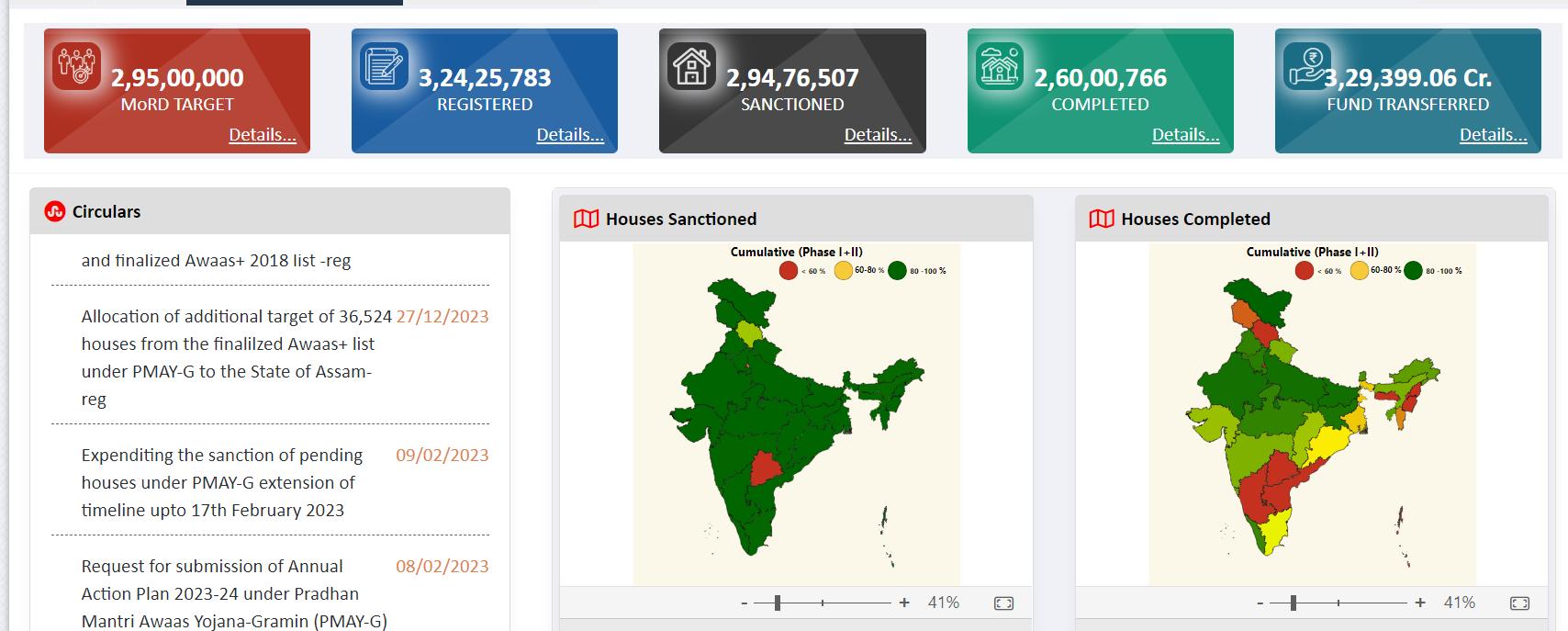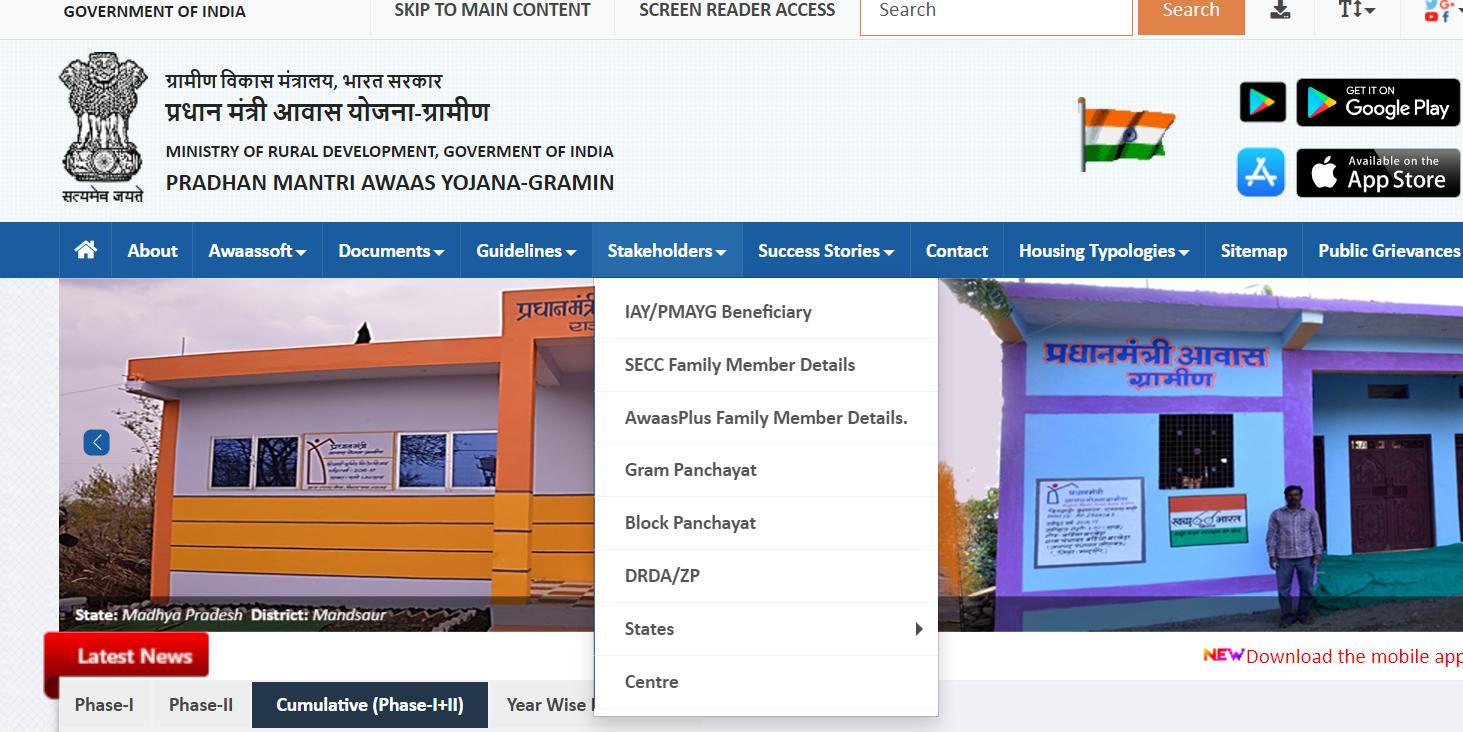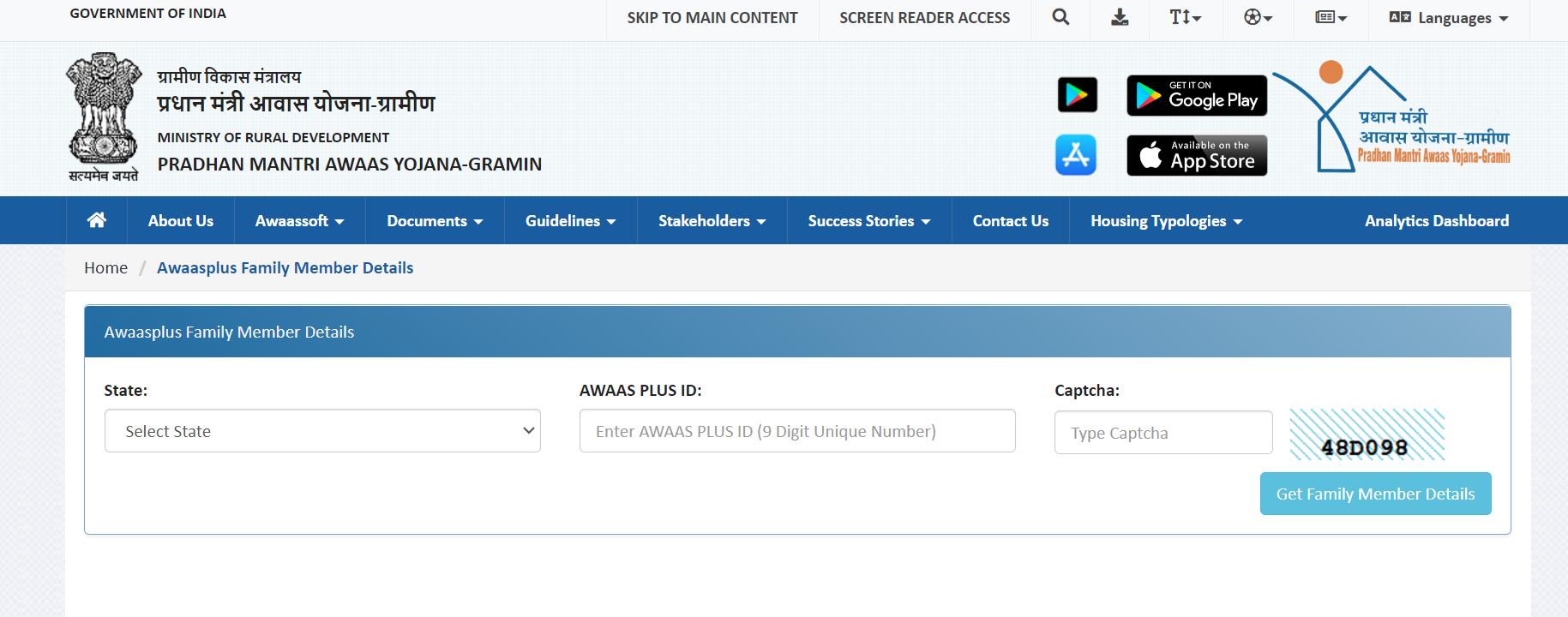



Table of Contents
- PMAY-G 2025
- What is Pradhan Mantri Awaas Yojana Gramin?
- Highlights of PMAY Gramin 2024
- Advantages of Pradhan Mantri Awaas Yojana Gramin (PMAY-G) Scheme
- Documents Required To Apply For PMAY-G (Rural)
- Eligibity Criteria For Pradhan Mantri Awaas Yojana Gramin 2024 Beneficiaries:
- Who are Excluded from being Beneficiaries in PMAY-G?
- How to Register a Beneficiary on PMAY-G?
- How to Find Your Name in PMAY Gramin Beneificiary list?
- How to check PMAY Gramin Application status using Fund Transfer Order (FTO)
- How to access AwaasPlus Family member Details?
- How to check SECC Family Member Details
- AWAAS - Mobile App for PMAY-G
- Benefits of PMAY-G
- Contact Details
- Conclusion
- Faq's
PMAY-G 2025
The Pradhan Mantri Awas Yojana Gramin (PMAY-G) has been extended to continue providing affordable housing to rural populations. The Union Cabinet approved the construction of an additional two crore houses from 2024 to 2029, with a total outlay of ₹3,06,137 crore. For the fiscal year 2024-25, ₹54,500 crore has been allocated to support this initiative.
Key Updates for 2025:
- Financial Assistance: Beneficiaries in plain areas will receive ₹1.20 lakh, while those in the North Eastern and Hill States will receive ₹1.30 lakh for house construction.
- Progress: As of February 2, 2025, over 39.82 lakh houses have been sanctioned under PMAY-G out of a target of 84.37 lakh houses for the 2024-25 period.
- Application Process: Eligible beneficiaries can apply through the official PMAY-G portal or via the AwaasPlus 2024 mobile application, which streamlines the registration process.
The government remains committed to its mission of "Housing for All," aiming to improve living conditions and provide secure housing for rural communities across India.
 Performance of PMAY-G - Housing for All
Performance of PMAY-G - Housing for All
What is Pradhan Mantri Awaas Yojana Gramin?
Pradhan Mantri Awaas Yojana Gramin (PMAY-G) was launched on April 1, 2016, as the flagship rural housing mission by the Ministry of Rural Development (MoRD), with implementation overseen by the Ministry of Housing and Urban Affairs (MoHUA). Its primary objective is to provide permanent housing with essential amenities to households without homes or living in kutcha or dilapidated houses. PMAY G is a vital component of the government's Housing for All initiative, aiming to address the rural housing shortage across India.
Under PMAY G, houses are constructed with a minimum size of 25 square meters, ensuring a dedicated space for hygienic cooking. Beneficiaries are selected based on parameters outlined in the Socio-Economic and Caste Census (SECC) and verified by Gram Sabhas. The funds are directly transferred to the Aadhaar-Linked Bank Account or Post-Office Account of the beneficiary, ensuring transparency and accountability.
As of September 27, 2022, PMAY-G has facilitated the construction of 2.00 crore houses out of the targeted 2.72 crores. Recently extended till March 31, 2024, PMAY-G continues its mission to bridge the rural housing deficit and uplift the living standards of vulnerable communities across India.
Highlights of PMAY Gramin 2024
Name of the Scheme | Pradhan Mantri Awas Yojana Gramin |
Beneficiaries | Low-Income Group and below the poverty line |
Objective of the Scheme | 2.95 crore pucca homes |
Last Date to avail the scheme | Dec 31,2024 |
Website to apply | G@https;//pmayg.nic.in/ |
App | Awaas |
Advantages of Pradhan Mantri Awaas Yojana Gramin (PMAY-G) Scheme
1) All beneficiaries of this scheme can avail of loans of up to Rs. 70,000 from pre-determined financial institutions. This sum will then be used to build a permanent dwelling.
2) There are some benefits available when repaying this amount. For one, interest rates will be lower by 3% when compared to ordinary, non-subsidized loans.
4) The maximum principal amount for which subsidy can be sought is Rs. 2 Lakh.
5) Added benefits like LPG connections covered under the Ujjwala Yojana and other essential facilities also exist.
6) Financial assistance for the construction of a new house under PMAY-G is Rs.1,20,000/- in plain areas and Rs.1,30,000/- in hilly/difficult/IAP areas.
Also Read: DDA Housing Scheme: Application, Eligibility, Flat Price 2024
Documents Required To Apply For PMAY-G (Rural)
1) Identification Proof such as Voter Id card and Aadhar Card
2) A Bank account or a Post Office Account
3) A job card number registered under MGNREGA
4) An affidavit stating the beneficiary does not have a pucca house
5) Swachh Bharat Mission (SBM) number of the beneficiary
Also Read: Kutcha Houses and Pucca Houses: Differences, Types, Benefits
Eligibity Criteria For Pradhan Mantri Awaas Yojana Gramin 2024 Beneficiaries:
The scheme gives the most priority to families which are the most deprived. PMAY gives priority to beneficiaries with the below listed socio-economic parameters
- Families residing in zero, one, or two-room dwellings with kutcha walls and roofs, based on SECC data and exclusion processes.
Automatic Inclusion will be done for :
- Homeless households
- Destitute individuals dependent on alms
- Manual scavengers
- Members of Primitive Tribal Groups
- Former bonded laborers
Prioritisation within Eligible Beneficiaries:
- Prioritisation involves multiple layers, starting with housing deprivation parameters categorised under SC/ST, Minorities, and Others.
- Preference is given to households based on homelessness and the number of rooms in their dwelling, with special attention to SC/ST, Minorities, and Others.
- Automatically included households receive elevated priority, determined by their cumulative deprivation scores calculated from various socio-economic parameters.
Socio-economic parameters considered for scoring include:
- Adult members aged 16 to 59
- Female-headed households without adult males aged 16 to 59
- Illiterate adults above 25 years
- Disabled members without able-bodied adults
- Landless households reliant on manual labor
Earmarking of Targets:
- 60% of the target is allocated to SC/ST households, with interchangeable targets based on availability.
- 15% of the total fund is earmarked for Minorities, allocated based on their rural population proportion.
- Provisions are made to ensure that 3% of beneficiaries are Persons with Disabilities (PwDs) at the state level.
- In cases of tied deprivation scores, priority is given to households with widows, next-of-kin of defense personnel, individuals with leprosy, cancer, or HIV, and households with a single girl child and Transgender persons.
Who are Excluded from being Beneficiaries in PMAY-G?
- Families living in houses with pucca roofs and/or pucca walls and households living in houses with more than 2 rooms are filtered out.
The following 13 parameters are automatically excluded from the remaining household set:-
- A motorised two-wheeler, three-wheeler, or four-wheeler vehicle a fishing boat with a motorised three-wheeler or four-wheeler tractor a Mechanised three/four-wheeler agricultural equipment
- Having a Kisan Credit Card with a credit limit of Rs.50,000 or above
- Household with any member as a Government employee
- Households with non-agricultural enterprises registered with the Government
- Any member of the family earning more than Rs.10,000 per month
- Any member of the family Paying income tax
- Any member of the family Paying professional tax
- If the family owns a refrigerator
- Own a landline phone
- Own 2.5 acres or more of irrigated land with at least one irrigation equipment
- 5 acres or more of irrigated land for two or more crop seasons
- Owning at least 7.5 acres of land or more with at least one irrigation equipment
How to Register a Beneficiary on PMAY-G?
Access the Official Website: Visit the official PMAY-G website and log in to your account.
You can also download the Awaas App for Registration of Beneficiary
Caption
Personal Details Section:
Fill in Personal Information: Provide essential details such as gender, mobile number, and Aadhaar number.
Upload Consent Form: Upload the consent form required to use the Aadhaar number.
Search for Beneficiary: Click on the search button to find the beneficiary name, PMAY ID, and priority.
Select to Register: Choose the beneficiary from the search results and click on "Select to Register."
Fill in Beneficiary Details:
Ownership Type: Specify the type of ownership (individual, joint, etc.).
Relation: Enter the relationship of the beneficiary with the applicant.
Aadhaar Number: Provide the Aadhaar number of the beneficiary.
Upload Consent Form: Upload the consent form for using the Aadhaar number.
Bank Account Details Section:
Add Account Information: Enter the beneficiary's bank account details, including the account number.
Loan Application: If the beneficiary intends to avail a loan, select "Yes" and enter the required loan amount.
Convergence Details Section:
MGNREGA Job Card Number: Input the MGNREGA job card number of the beneficiary.
SBM Number: Enter the Swachh Bharat Mission (SBM) number, if applicable.
Details from the Concerned Office:
This section will be completed by the relevant office handling beneficiary registrations.
By following these step-by-step instructions, you can successfully register a beneficiary on PMAY-G, ensuring access to housing assistance and related benefits.
How to Find Your Name in PMAY Gramin Beneificiary list?
To find your name in the PMAY Gramin beneficiary list, follow these steps:
Download the official app Awaas and select the option Search Beneficiary/scan QR code
Or
Go to the official website of PMAY Gramin -https://awaassoft.nic.in/netiay/Benificiary.aspxCaption
Official Website of PMAY-G
Step 2: In the main tab, select the Stakeholders drop down menu, and select the first option - IAY/PMAYG Beneficiary
Caption
Step 3: Enter the registration number generated at the time of Beneficiary Registration and click on submit to initiate the search process.
Step 4: Once you submit the details, the website will display the search results. If your name is included in the PMAY Gramin beneficiary list, it should appear in the search results along with other relevant information.
Step 5: Carefully review the information displayed to ensure that it matches your details accurately. Verify your name, address, and other relevant details provided in the beneficiary list.
If you encounter any discrepancies or issues with finding your name in the beneficiary list, you may need to contact the relevant authorities responsible for managing the PMAY Gramin scheme. They can provide necessary assistance and address any concerns you may have.
By following these steps, you can easily find your name in the PMAY Gramin beneficiary list and access the benefits provided under the scheme.
How to check PMAY Gramin Application status using Fund Transfer Order (FTO)
Step 1: Visit the official website and Login
Step 2: Select 'Awaasoft' option in the home page and from the drop down menu, click on 'FTO Tracking' option
Step 3: Enter the FTP number or PFMS Id followed by the Captcha Code and submit
Step 4: The application status will be displayed on screen
How to access AwaasPlus Family member Details?
Step 1: Go to the official website
Step 2: Select 'Stakeholder' option in the home page and from the drop down menu, click on Awaasplus Family member details

Step 3: On the new page, select the correct state and the unique 9-digit Awaasplus ID and Captcha code.
Step 4: Click on the 'Get Family Member Details' Button to get the details.
How to check SECC Family Member Details
Step 1: Go to the official website
Step 2: Select 'Stakeholder' option in the home page and from the drop down menu, click on SECC Family member details
Step 3: On the new page, select the correct state and the uniquePMAYID and Captcha code.
Step 4: Click on the 'Get Family Member Details' Button to get the details.
You can generate the PMAYID and Awaasplus ID by visiting The Data Entry tab on the official homepage
AWAAS - Mobile App for PMAY-G
The Awaas App, also known as Awaas+, is a mobile application developed as part of the Pradhan Mantri Awaas Yojana (PMAY) initiative in India by National Informatics Centre (NIC). The app aims to capture details of potentially eligible households for the PMAY-G (Gramin) program, which targets houseless and those living in kutcha wall and kutcha roof housesCaption
One can use the application for inspection login, beneficiary login, FTO Tracking and beneficiary search The app also promotes transparency and accountability in the selection of beneficiaries, reducing the risk of corruption and ensuring that the benefits reach the intended recipients.
Benefits of PMAY-G
Access to Pucca Houses: PMAY-G aims to provide pucca houses with basic amenities to eligible beneficiaries, ensuring improved living conditions and better shelter.
Addressing Rural Housing Shortage: The scheme addresses the rural housing shortage by constructing houses for houseless households and those living in kutcha and dilapidated houses, thereby bridging the housing deficit in rural areas.
Contributing to Housing for All Mission: PMAY-G significantly contributes to the mission of Housing for All by extending housing benefits to deserving rural households, thereby promoting inclusive growth and development.
Minimum House Size: Under PMAY-G, the minimum size of houses is increased to 25 square meters, providing more spacious and comfortable living spaces for beneficiaries.
Direct Benefit Transfer (DBT): The financial assistance under PMAY-G is directly transferred to the Aadhaar-linked bank accounts or post-office accounts of the beneficiaries, ensuring transparency and eliminating intermediaries.
Identification of Beneficiaries: Beneficiaries are identified using the Socio-Economic and Caste Census (SECC) parameters and verified by Gram Sabhas, ensuring that assistance is targeted at genuinely deprived households.
Extended Coverage: As of September 27, 2022, PMAY-G has already constructed 2.00 crore houses out of the total target of 2.72 crores, showcasing the scheme's substantial coverage and impact.
Overall, PMAY-G provides tangible benefits to rural households by addressing their housing needs and improving their quality of life.
Contact Details
PMAY-G
Toll Free Number: 180011 6446
Mail Us: support-pmayg[at]gov[dot]in
Conclusion
In conclusion, the Pradhan Mantri Awaas Yojana Gramin (PMAY-G) emerges as a transformative initiative aimed at fulfilling the housing needs of rural India. From its inception rooted in the nation's post-independence era to its current avatar as PMAY-G, the program has evolved into a beacon of hope for millions of households living in inadequate shelter. By providing pucca houses with essential amenities, PMAY-G not only addresses the rural housing shortage but also contributes significantly to the government's mission of Housing for All by 2024.
Through its streamlined beneficiary selection process, direct benefit transfers, and extended coverage, PMAY-G ensures transparency, accountability, and inclusivity. The scheme's emphasis on identifying the most deprived households, prioritizing them based on socio-economic parameters, and earmarking targets for marginalized communities underscores its commitment to equitable development.
As PMAY-G continues to march towards its ambitious target of constructing 2.95 crore pucca houses by 2024, it remains a testament to the government's unwavering dedication to improving the lives of rural citizens. By providing not just shelter, but dignity and security, PMAY-G stands as a cornerstone of India's journey towards socio-economic empowerment and inclusive growth.
explore further
Latest from Editorials
More from Publications
Resources
Dwello, for every home buyer, is a way to go from 'I feel' to 'I know', at no extra cost.




